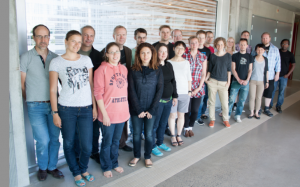
Dr Sinclair (right) at the OpenIFS meeting.
Professor Heikki Järvinen and researcher Victoria Sinclair use the numerical weather forecast model OpenIFS, recently released by the European Centre for Medium-Range Weather Forecasts (ECMWF), in their teaching and research. OpenIFS is an open version of the IFS system currently in use at ECMWF for operational weather forecasting. IFS is the leading model in its field: it has excellent forecasting ability for more than 6 days on average (measured by an 80% anomaly correlation limit) and was able to predict the track of superstorm Sandy as many as 7.5 days before the storm struck New York. The main competitors of the IFS are the Met Office and NCAR numerical forecast models.
In early June, Prof Järvinen and Dr Sinclair organised a 3-day workshop at the University of Helsinki for users to discuss OpenIFS model and its future prospects. Hands-on tutorials were organized with help of ECMWF staff at the computer rooms of the Physicum. All participants ran the model at the CSC’s CRAY supercomputer and analysed the results with the Metview visualization tools.
Prof Järvinen is a happy user of OpenIFS: “We are one of the first universities to have a licence for OpenIFS. With the OpenIFS, we can study questions about atmospheric dynamics that are both relevant and inspiring for the students. OpenIFS represents top-end science and there is potential for societal impact though its operational use. In our division, we have strong expertise in GHG, aerosols, and atmospheric processes, but OpenIFS also gives an opportunity to study marine aspects, which is on our agenda as well. In addition, by educating our students to use and understand numerical weather forecast models, we provide them job-relevant skills which can be easily applied to the use of Earth system models.”
The Division of Atmospheric Sciences has a commitment to develop a cutting-edge numerical meteorology laboratory course, and OpenIFS is an ideal tool for that. “I think OpenIFS is right for us and provides rich opportunities. It is relatively easy to use and it has a multitude of research applications. It is modern, modular, well documented, and computationally extremely efficient. There are also excellent training opportunities at ECMWF and within the OpenIFS community”, says professor Järvinen.
Victoria Sinclair’s initial experience of using OpenIFS for research has been positive. “I started working with OpenIFS in January and all went well from the start; my aim was to use it to understand how weather systems transport moisture to the interior of Antarctica by means of case studies, sensitivity experiments, and by analysing large-scale dynamics. I also wanted to calculate moisture budgets and to use the model in teaching synoptic meteorology”, Victoria says. “I think OpenIFS is a very good tool for a teacher to explain how weather systems work.”
Victoria found OpenIFS practical and easy to use. “IFS is a state-of-the-art numerical weather prediction model and well known internationally. It is computationally efficient, and as a global model, there are no difficult lateral boundary conditions. One simulation may have more than one use; furthermore, I can study both polar regions at once. IFS is well tested and well documented; as a European model, it is also more acceptable for some European funding agencies than American models.”
What about weak points? “Well, there are relatively few academic users at the moment, and this limits the sources of help and advice. If I have a problem with something, it is unlikely that someone else has ended up in the same situation before outside ECMWF. Also, the output is not that user friendly. I changed from IFS’s plotting programme, Metview to Matlab at some point, although Metview definitely has lots of potential. I just need to invest some time to learn how to use it.“
In summary, Prof Järvinen and Dr Sinclair think that OpenIFS is a very promising project for researchers, and for teaching, but that there is still quite a lot of room for improvement, especially in terms of user-friedliness.
Tanja Suni, Heikki Järvinen, Victoria Sinclair
More information about ECMWF, IFS, and OpenIFS
http://www.ecmwf.int/
http://www.ecmwf.int/research/ifs/
https://software.ecmwf.int/wiki/display/OIFS/OpenIFS+Home
 When the calendar reads June and the Scandinavian countries register the warmest temperatures in Europe, the most intuitive idea is not to stay indoors, draw down the curtains and start coding. However, that was exactly what 18 students and assistants did when the first summer school on atmospheric modelling took place in the modern building of Ingvar Kamprad Design Centre, Lund University, Lund, Sweden.
When the calendar reads June and the Scandinavian countries register the warmest temperatures in Europe, the most intuitive idea is not to stay indoors, draw down the curtains and start coding. However, that was exactly what 18 students and assistants did when the first summer school on atmospheric modelling took place in the modern building of Ingvar Kamprad Design Centre, Lund University, Lund, Sweden.

